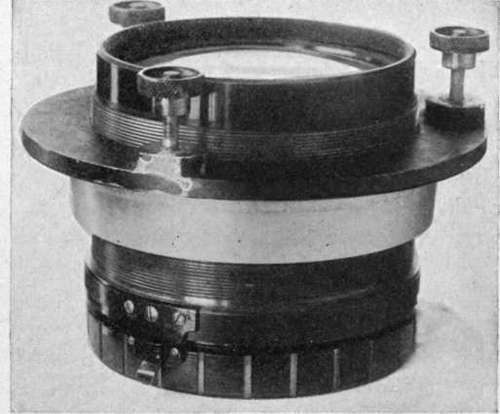Lens Mounts
Description
This section is from the book "Airplane Photography", by Herbert E. Ives. Also available from Amazon: Airplane photography.
Lens Mounts
All that is required for the mounting of an aerial camera lens is a rigid platform, with provision for enough motion of the lens to adjust its focus accurately. As already explained, the lens works at fixed, infinity, focus, and therefore needs no adjustment during use. It must be held far more rigidly than would be possible by the bellows, which is an almost invariable adjunct of focussing cameras. The use of ordinary types of hand cameras on a plane is rarely successful just because of the bellows, which is strained and rattled by the rush of wind.
The lens mountings thus far used have been simple affairs. In the French cameras the lens is merely screwed into a flange which in turn is fastened by screws to a platform in the camera body. Adjustment for focussing is not provided; instead, the flange is raised on thin metal rings or washers, cut of such thickness by trial as to bring the lens to focus, once and for all.
The U. S. Air Service method of mounting is to provide the lens barrel with a long thread, which screws into a flange that in turn is mounted on a platform in the camera cone, by means of thumb-screws. The lens is focussed by screwing in and out, and then clamped by a screw through the side, bearing on the thread. The whole mount may be quickly removed by loosening the thumb-screws, and once focussed in one cone, can be transferred to another similar, machine-made cone without change of focus. Fig. 18 shows a 20 inch lens mounted in this manner. The photograph shows as well the ring on the front of the lens by means of which circular color filters may be held in place.

Fig. 18. - 50 centimeter F/6 lens in U. S. standard mount, showing color filter retaining ring and catch.
This ring screws down on the filter, and the catch is dropped into the nearest vertical groove to the tight position.
A somewhat different and better method of tightening the lens in the flange, when focussed, has been adopted in the English lens mount, which is in general similar to the American. The threaded part of the flange is split by a slot cut parallel to the flange base, and a screw is run into the flange from the front, through the split portion. By tightening this screw, which is always accessible, the split part of the flange is squeezed together, thus rigidly holding the lensbarrel.
Continue to:
- prev: Focussing
- Table of Contents
- next: Chapter V. The Shutter. Permissible Exposure In Airplane Photography
Tags
camera, lens, airplane, aerial, film, exposure, photography, maps, birdseye
